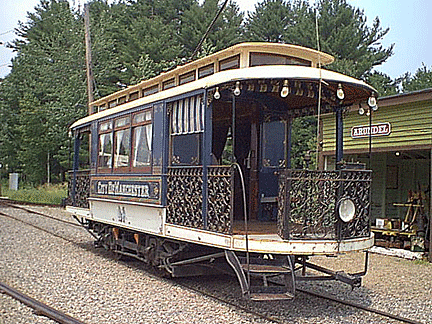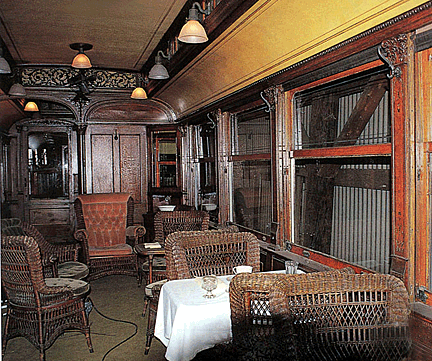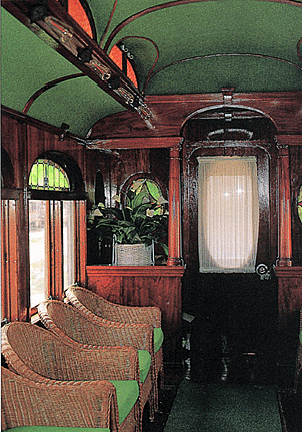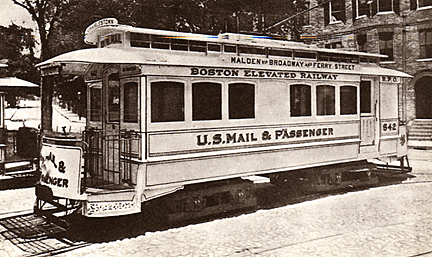|
 In
addition to the usual roster of open and closed passenger cars, the typical
street railway company owned a variety of specialized cars. Originally
intended for use by company officials on inspection trips, parlor trolleys
appeared quite widely in the 1890s. In
addition to the usual roster of open and closed passenger cars, the typical
street railway company owned a variety of specialized cars. Originally
intended for use by company officials on inspection trips, parlor trolleys
appeared quite widely in the 1890s.
Generally luxurious, parlor-car trolleys gleamed with brass fittings, richly
curtained windows, wall-to-wall carpeting,
decorated ceilings, polished mahogany paneling, and colored glass in the
clerestory.
The directors of the Connecticut Traction Company could avail themselves in
their car of a lavatory that was shielded from common gaze by stained glass
windows of almost paralyzing elegance.
 In
Manchester, New Hampshire, the directors' car had enough fancy scrolled
ironwork for a New Orleans building front. In Denver a parlor car had a
"tasteful ceiling of Paris green, with dark green border ornamented in
gold." This one also offered 16 rattan easy chairs, 8 glittering spittoons,
and mother-of-pearl call buttons with which a faint director could summon
refreshment to his easy chair. In
Manchester, New Hampshire, the directors' car had enough fancy scrolled
ironwork for a New Orleans building front. In Denver a parlor car had a
"tasteful ceiling of Paris green, with dark green border ornamented in
gold." This one also offered 16 rattan easy chairs, 8 glittering spittoons,
and mother-of-pearl call buttons with which a faint director could summon
refreshment to his easy chair.
In St. Louis, the private car Mabel not only had special lockers for china,
glassware, and linen, but also an icebox, sink, built-in desk, rich
portieres opalescent glass, and an overstuffed loveseat.
 Even
though originally built to enhance self esteem of officials, these deluxe
trolleys soon found additional service on charter trips. Many a citizen
would willingly plunk down $20 or $30 on spare-no-expense occasions such as
weddings or anniversaries so that he or she could glide elegantly through
the streets in publicly displayed privacy. Other parlor-car occasions
inlcuded fraternal affairs, bachelor dinners, and special sightseeing tours
for visiting dignitaries. Even
though originally built to enhance self esteem of officials, these deluxe
trolleys soon found additional service on charter trips. Many a citizen
would willingly plunk down $20 or $30 on spare-no-expense occasions such as
weddings or anniversaries so that he or she could glide elegantly through
the streets in publicly displayed privacy. Other parlor-car occasions
inlcuded fraternal affairs, bachelor dinners, and special sightseeing tours
for visiting dignitaries.
Often, too, people chartered them for funerals. Many companies in the larger
cities had cars especially built for the purpose.
Frequently named instead of numbered, these cars provided a special casket
compartment up front with plate glass windows and a large glass door that
allowed the coffin to be viewed from the street; a nickel-plated rail
against which flowers could be banked; 8 black leather seats in the casket
compartment for first-degree mourners, and 24 seats in the rear for lesser
grievers.
 Smaller
or less affluent lines used an ordinary combine car with the usual baggage
compartment at one end to hold the casket, and a passenger section occupying
the remaining two-thirds of the car for those attending the funeral.
Companies charged a moderate $20-26 for all these somber but choice
conveniences, a fee that included the services of a neatly dressed motorman
and conductor. Smaller
or less affluent lines used an ordinary combine car with the usual baggage
compartment at one end to hold the casket, and a passenger section occupying
the remaining two-thirds of the car for those attending the funeral.
Companies charged a moderate $20-26 for all these somber but choice
conveniences, a fee that included the services of a neatly dressed motorman
and conductor.
Postal cars operated on many of the larger systems. Painted red, white and
blue, these colorful cars ran over established routes on specific schedules,
picking up mail from corner boxes and transporting it to the main post
office. Like the familiar Railway Post Office cars, until recently an
inseparable part of every respectable passenger train, the Post Office
equipped the trolley versions with a mail slot on each side in which letters
could be deposited by the sender.
Next:
Accidents Will Happen
|
